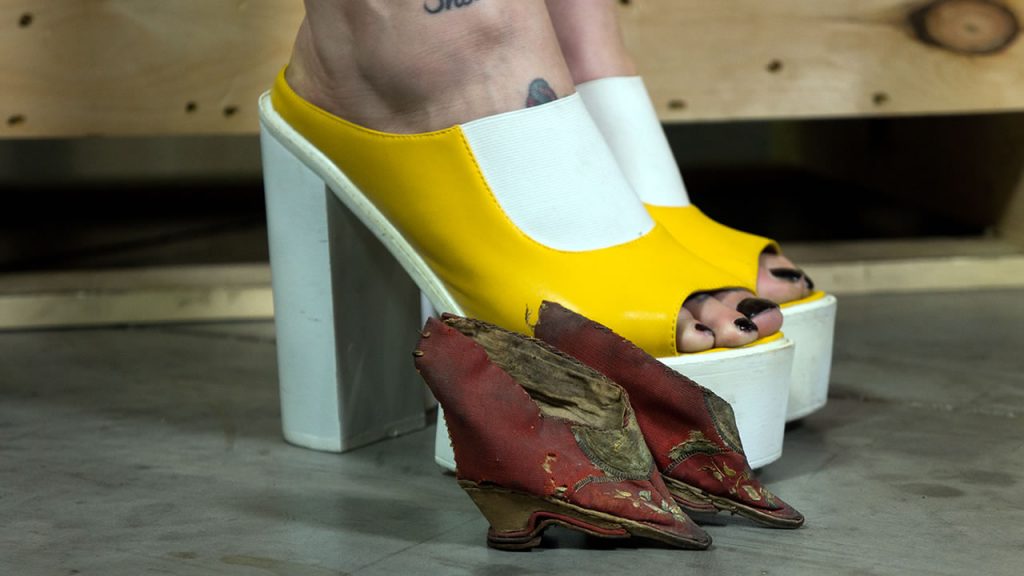Winner of the Fall 2016 StMU History Media Award for
Best Use of Scholarship
Best Article in the Category of “World History”
Best Use of Primary Sources
When I knew I couldn’t suffer another moment of pain and tears fell on my bloody bindings, my mother spoke softly into my ear, encouraging me to go one more hour, one more day, one more week, reminding me of the rewards I would have if I carried on a little longer. In this way, she taught me how to endure—not just the physical trials of footbinding or childbearing, but the more torturous pain of the heart, mind, and soul.1
More often than necessary, women are consumed with the idea of infatuation. Every culture has its own form of standards that pertain to women and what constitutes beauty. Although the world is slightly more accepting now, women used to go to extreme lengths to achieve an image that would be deemed attractive. In the Chinese culture, foot binding was that well-known beauty expectation for centuries. What started off as a celebrity fad, turned into a way of determining social status and eventually an all-around beauty expectation. 2 The objective of foot binding was for women to have the smallest foot possible, starting at very young ages. Not only was this a painful process for girls as young as five years, but it also promoted the idea that women must mutilate their bodies to become appealing to men. At some point in time, women began to just accept that this was something that was supposed to be done in order to be attractive. Often referred to as “lotus boats” or “golden lotuses,” bound feet started as a fad for the famous, and slowly made its way to becoming the social norm.3

This practice began around the tenth century with women in the entertainment business. These women were adored for their tiny arched feet and were seen by men to be much more attractive than middle class women with average feet. As these dancers were gaining an audience, the idea of “lotus feet” was becoming familiar. Not long after these performers expressed their “beauty,” foot binding became a norm for women who wanted to fit in and even for those who had a desire to find a husband.4 This painful process consisted of the breaking of young girl’s toes to form the desired triangular shape. Then the arch of the foot would be bent horizontally from the toes all the way to the heel. As if this was not painful enough, the girls were forced to walk on their feet to intensify the arch, breaking the foot even more. After all of this, the foot would be wrapped to maintain the shape of it as well as prevent any sort of deviation.5

Although this practice was around for centuries, it was only a matter of time before someone realized how inhumane and cruel it really was. Thankfully, many people began to protest against foot binding, forming “anti-foot binding organizations” to raise awareness on the inhumanity of binding women’s feet. By the 1950’s, laws were passed, allowing women to unbind their feet. Although hesitant at first, the trend slowly declined. Many women protested to unbinding their feet, due to the fact that it had been a social norm a thousand years. However, the movement against foot binding continued and eventually the last of the factories that make the tiny shoes were shut down, disabling the women from continuing the custom. Today, foot binding is no longer practiced and the only women who continue to maintain the tiny feet are those elder women who refuse to let go of the past.6
- Lisa See, Snow Flower and the Secret Fan (New York: Random House Publishers, 2005), 3-4. ↵
- Yaodong Gu et al., “Foot Loading Characteristics of Chinese Bound Feet Women: A Comparative Analysis,” PLoS ONE 10, no. 4 (April 2015): 1–9, doi:10.1371/journal.pone.0121695. ↵
- Yu-ning Li, Chinese Women Through Chinese Eyes (New York: Routledge, 2015), 125-127. ↵
- Women in the Middle Ages: An Encyclopedia, 2004, s.v. “Footbinding (Late 10th Century-early 20th Century),” by Patricia Buckley Ebrey. ↵
- Amanda Foreman, “Why Footbinding Persisted in China for a Millennium,” Smithsonian, accessed November 8, 2016, http://www.smithsonianmag.com/history/why-footbinding-persisted-china-millennium-180953971/. ↵
- “Women with Bound Feet in China,” Reshaping the Body: Clothing & Cultural Practice, accessed November 8, 2016, http://exhibits.hsl.virginia.edu/clothes/lady_bound/. ↵



189 comments
Johnanthony Hernandez
Great article, I remember watching a short documentary that talked briefly about foot binding a few years back. But it was such a short segment that it really didn’t cover as much as your article did. It’s astonishing that this was practiced for so long and into the modern age. As well as that it was only recently that women were able to unbind their feet.
Sam Vandenbrink
Great article, crazy to think people actually did that to there bodies just because of vanity. It seems as if in my opinion that people now days wouldn’t even notice if someones feet were allot smaller then average. It shows allot about the men in the culture as well because they were more attracted to it, causing more women in the society to do bind there feet. Very strong article, allot of information and great pictures!
Gabriela Serrato
I had heard of foot binding but I was very interested in reading this article to understand it more. It is so interesting how different cultures have such a variety of ways to distinguish beauty among women. It is also interesting that when one is raised in these cultures, they do not think of these acts as bizarre like an outsider would. So this makes me think of ways women in the United States today alter their bodies that maybe other cultures would think it weird. Some women get breast augmentations or nose jobs, and even lip fillers, and other cultures may even today find it to be weird.
Lianna Ybarra
Very interesting article! I had no idea that Chinese women did this. It hurts my feet just looking at the pictures! It’s sad though to think that these women had to do this so they would be found as more attractive by society. This shows that even then there were problems with how society viewed women and how they should look/act. I’m glad though that it is no prohibited because it was a medical issue that could have become worse if this tradition continued.
Cesar Zavala
Awesome article about such an inhumane practice. I had heard of foot binding before and how Asian women would make this sacrifice in order to be more beautiful. I had also heard that another reason that men liked women with bound feet was so that it was more difficult for them to run away. I thought it was insane when I heard this. Very well written article and cringe worthy photos.
Jennifer Pogue
Great article! In elementary school I remember reading a story about this, but it obviously was not as descriptive. It is so sad to imagine the pain of binding the feet for years. I get tired wearing heels for an hour. Today there is plastic surgery, but that pain can be controlled through medications and we can be healed faster. It is sad that some women feel they must change themselves because of social pressures. Overall very engaging and descriptive article.
Marissa Gonzalez
This article was very interesting! It is crazy how women and girls were forced to do this to their feet just so men can find them attractive. Foot binding was in fact very painful and I cannot imagine doing this myself. This culture is different which is why I find this a very extreme thing to do. Beauty is defined in a different way for a different culture. This is something that is very interesting to me even though not all aspects of beauty seem pleasant such as foot binding just because it was painful. This is probably why the phrase, “beauty hurts”, exists today.
Aimee Trevino
Really interesting article! I really enjoyed how you explained with a lot of detail, and went in order of how this all came into place. As you said different cultures and generations will have different ideals of beauty, but to see women go through this mutilation, and breaking their bones from a young age is so sad. I guess I could see how to them it was a sense of high society, since they had to be so looked after, and even carried since most were not able to walk. Overall, really informative thanks.
Mario De Leon
This article was very interesting and descriptive. It is interesting to point out that different cultures have different perspectives of what makes a woman beautiful. That being said, the practice of Chinese foot binding is horrible and it is sad to think of what women had to go through just to achieve beauty. While Chinese foot binding is horrific it is sad to think that people still today put their bodies through great pain to achieve beauty.
Andrew Gray
What a barbaric practice! The notion of physically impairing oneself in the name of beauty is, thankfully, one of the past, though perhaps piercings and tattooing are somehow the modern equivalent of body modification. It’s a really far out notion that the women who participated in this practice were attempting to please the men who found these women to be “much more attractive” than those with “average feet”. The fact that this was all self inflicted really makes me greatly respect the women that underwent all that pain.